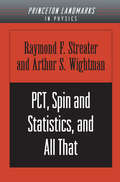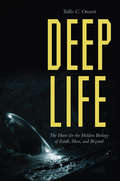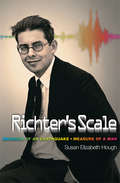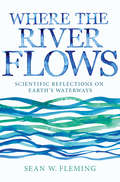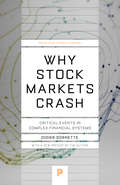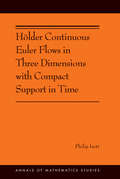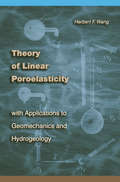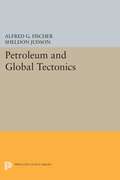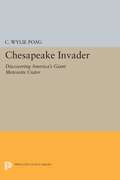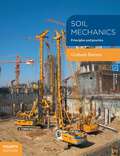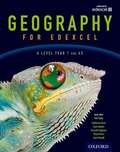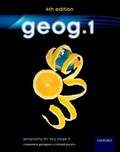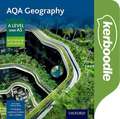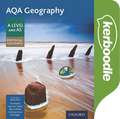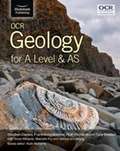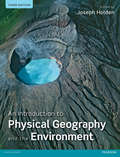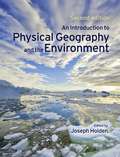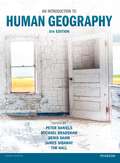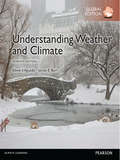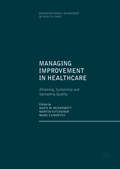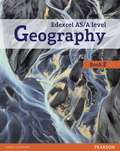- Table View
- List View
PCT, Spin and Statistics, and All That
by Raymond F. Streater Arthur S. WightmanPCT, Spin and Statistics, and All That is the classic summary of and introduction to the achievements of Axiomatic Quantum Field Theory. This theory gives precise mathematical responses to questions like: What is a quantized field? What are the physically indispensable attributes of a quantized field? Furthermore, Axiomatic Field Theory shows that a number of physically important predictions of quantum field theory are mathematical consequences of the axioms. Here Raymond Streater and Arthur Wightman treat only results that can be rigorously proved, and these are presented in an elegant style that makes them available to a broad range of physics and theoretical mathematics.
Deep Life: The Hunt for the Hidden Biology of Earth, Mars, and Beyond
by Tullis C. OnstottDeep Life takes readers to uncharted regions deep beneath Earth's crust in search of life in extreme environments and reveals how astonishing new discoveries by geomicrobiologists are helping the quest to find life in the solar system.Tullis Onstott, named one of the 100 most influential people in America by Time magazine, provides an insider’s look at the pioneering fieldwork that is shining vital new light on Earth’s hidden biology—a thriving subterranean biosphere that scientists once thought to be impossible. Come along on epic descents two miles underground into South African gold mines to experience the challenges that Onstott and his team had to overcome. Join them in their search for microbes in the ancient seabed below the desert floor in the American Southwest, and travel deep beneath the frozen wastelands of the Arctic tundra to discover life as it could exist on Mars.Blending cutting-edge science with thrilling scientific adventure, Deep Life features rare and unusual encounters with exotic life forms, including a bacterium living off radiation and a hermaphroditic troglodytic worm that has changed our understanding of how complex subsurface life can really be. This unforgettable book takes you to the absolute limits of life—the biotic fringe—where today’s scientists hope to discover the very origins of life itself.
Deep Life: The Hunt for the Hidden Biology of Earth, Mars, and Beyond (PDF)
by Tullis C. OnstottDeep Life takes readers to uncharted regions deep beneath Earth's crust in search of life in extreme environments and reveals how astonishing new discoveries by geomicrobiologists are helping the quest to find life in the solar system.Tullis Onstott, named one of the 100 most influential people in America by Time magazine, provides an insider’s look at the pioneering fieldwork that is shining vital new light on Earth’s hidden biology—a thriving subterranean biosphere that scientists once thought to be impossible. Come along on epic descents two miles underground into South African gold mines to experience the challenges that Onstott and his team had to overcome. Join them in their search for microbes in the ancient seabed below the desert floor in the American Southwest, and travel deep beneath the frozen wastelands of the Arctic tundra to discover life as it could exist on Mars.Blending cutting-edge science with thrilling scientific adventure, Deep Life features rare and unusual encounters with exotic life forms, including a bacterium living off radiation and a hermaphroditic troglodytic worm that has changed our understanding of how complex subsurface life can really be. This unforgettable book takes you to the absolute limits of life—the biotic fringe—where today’s scientists hope to discover the very origins of life itself.
Richter's Scale: Measure of an Earthquake, Measure of a Man
by Susan Elizabeth HoughBy developing the scale that bears his name, Charles Richter not only invented the concept of magnitude as a measure of earthquake size, he turned himself into nothing less than a household word. He remains the only seismologist whose name anyone outside of narrow scientific circles would likely recognize. Yet few understand the Richter scale itself, and even fewer have ever understood the man. Drawing on the wealth of papers Richter left behind, as well as dozens of interviews with his family and colleagues, Susan Hough takes the reader deep into Richter's complex life story, setting it in the context of his family and interpersonal attachments, his academic career, and the history of seismology. Among his colleagues Richter was known as intensely private, passionately interested in earthquakes, and iconoclastic. He was an avid nudist, seismologists tell each other with a grin; he dabbled in poetry. He was a publicity hound, some suggest, and more famous than he deserved to be. But even his closest associates were unaware that he struggled to reconcile an intense and abiding need for artistic expression with his scientific interests, or that his apparently strained relationship with his wife was more unconventional but also stronger than they knew. Moreover, they never realized that his well-known foibles might even have been the consequence of a profound neurological disorder. In this biography, Susan Hough artfully interweaves the stories of Richter's life with the history of earthquake exploration and seismology. In doing so, she illuminates the world of earth science for the lay reader, much as Sylvia Nasar brought the world of mathematics alive in A Beautiful Mind.
Where the River Flows: Scientific Reflections on Earth's Waterways
by Sean W. FlemingThe vital interconnections that rivers share with the land, the sky, and usRivers are essential to civilization and even life itself, yet how many of us truly understand how they work? Why do rivers run where they do? Where do their waters actually come from? How can the same river flood one year and then dry up the next? Where the River Flows takes you on a majestic journey along the planet's waterways, providing a scientist's reflections on the vital interconnections that rivers share with the land, the sky, and us.Sean Fleming draws on examples ranging from common backyard creeks to powerful and evocative rivers like the Mississippi, Yangtze, Thames, and Congo. Each chapter looks at a particular aspect of rivers through the lens of applied physics, using abundant graphics and intuitive analogies to explore the surprising connections between watershed hydrology and the world around us. Fleming explains how river flows fluctuate like stock markets, what "digital rainbows" can tell us about climate change and its effects on water supply, how building virtual watersheds in silicon may help avoid the predicted water wars of the twenty-first century, and much more. Along the way, you will learn what some of the most exciting ideas in science—such as communications theory, fractals, and even artificial life—reveal about the life of rivers.Where the River Flows offers a new understanding of the profound interrelationships that rivers have with landscapes, ecosystems, and societies, and shows how startling new insights are possible when scientists are willing to think outside the disciplinary box.
Where the River Flows: Scientific Reflections on Earth's Waterways
by Sean W. FlemingThe vital interconnections that rivers share with the land, the sky, and usRivers are essential to civilization and even life itself, yet how many of us truly understand how they work? Why do rivers run where they do? Where do their waters actually come from? How can the same river flood one year and then dry up the next? Where the River Flows takes you on a majestic journey along the planet's waterways, providing a scientist's reflections on the vital interconnections that rivers share with the land, the sky, and us.Sean Fleming draws on examples ranging from common backyard creeks to powerful and evocative rivers like the Mississippi, Yangtze, Thames, and Congo. Each chapter looks at a particular aspect of rivers through the lens of applied physics, using abundant graphics and intuitive analogies to explore the surprising connections between watershed hydrology and the world around us. Fleming explains how river flows fluctuate like stock markets, what "digital rainbows" can tell us about climate change and its effects on water supply, how building virtual watersheds in silicon may help avoid the predicted water wars of the twenty-first century, and much more. Along the way, you will learn what some of the most exciting ideas in science—such as communications theory, fractals, and even artificial life—reveal about the life of rivers.Where the River Flows offers a new understanding of the profound interrelationships that rivers have with landscapes, ecosystems, and societies, and shows how startling new insights are possible when scientists are willing to think outside the disciplinary box.
Why Stock Markets Crash: Critical Events in Complex Financial Systems
by Didier SornetteThe scientific study of complex systems has transformed a wide range of disciplines in recent years, enabling researchers in both the natural and social sciences to model and predict phenomena as diverse as earthquakes, global warming, demographic patterns, financial crises, and the failure of materials. In this book, Didier Sornette boldly applies his varied experience in these areas to propose a simple, powerful, and general theory of how, why, and when stock markets crash. Most attempts to explain market failures seek to pinpoint triggering mechanisms that occur hours, days, or weeks before the collapse. Sornette proposes a radically different view: the underlying cause can be sought months and even years before the abrupt, catastrophic event in the build-up of cooperative speculation, which often translates into an accelerating rise of the market price, otherwise known as a "bubble." Anchoring his sophisticated, step-by-step analysis in leading-edge physical and statistical modeling techniques, he unearths remarkable insights and some predictions--among them, that the "end of the growth era" will occur around 2050. Sornette probes major historical precedents, from the decades-long "tulip mania" in the Netherlands that wilted suddenly in 1637 to the South Sea Bubble that ended with the first huge market crash in England in 1720, to the Great Crash of October 1929 and Black Monday in 1987, to cite just a few. He concludes that most explanations other than cooperative self-organization fail to account for the subtle bubbles by which the markets lay the groundwork for catastrophe. Any investor or investment professional who seeks a genuine understanding of looming financial disasters should read this book. Physicists, geologists, biologists, economists, and others will welcome Why Stock Markets Crash as a highly original "scientific tale," as Sornette aptly puts it, of the exciting and sometimes fearsome--but no longer quite so unfathomable--world of stock markets.
Why Stock Markets Crash: Critical Events in Complex Financial Systems
by Didier SornetteThe scientific study of complex systems has transformed a wide range of disciplines in recent years, enabling researchers in both the natural and social sciences to model and predict phenomena as diverse as earthquakes, global warming, demographic patterns, financial crises, and the failure of materials. In this book, Didier Sornette boldly applies his varied experience in these areas to propose a simple, powerful, and general theory of how, why, and when stock markets crash. Most attempts to explain market failures seek to pinpoint triggering mechanisms that occur hours, days, or weeks before the collapse. Sornette proposes a radically different view: the underlying cause can be sought months and even years before the abrupt, catastrophic event in the build-up of cooperative speculation, which often translates into an accelerating rise of the market price, otherwise known as a "bubble." Anchoring his sophisticated, step-by-step analysis in leading-edge physical and statistical modeling techniques, he unearths remarkable insights and some predictions--among them, that the "end of the growth era" will occur around 2050. Sornette probes major historical precedents, from the decades-long "tulip mania" in the Netherlands that wilted suddenly in 1637 to the South Sea Bubble that ended with the first huge market crash in England in 1720, to the Great Crash of October 1929 and Black Monday in 1987, to cite just a few. He concludes that most explanations other than cooperative self-organization fail to account for the subtle bubbles by which the markets lay the groundwork for catastrophe. Any investor or investment professional who seeks a genuine understanding of looming financial disasters should read this book. Physicists, geologists, biologists, economists, and others will welcome Why Stock Markets Crash as a highly original "scientific tale," as Sornette aptly puts it, of the exciting and sometimes fearsome--but no longer quite so unfathomable--world of stock markets.
Hölder Continuous Euler Flows in Three Dimensions with Compact Support in Time
by Philip IsettMotivated by the theory of turbulence in fluids, the physicist and chemist Lars Onsager conjectured in 1949 that weak solutions to the incompressible Euler equations might fail to conserve energy if their spatial regularity was below 1/3-Hölder. In this book, Philip Isett uses the method of convex integration to achieve the best-known results regarding nonuniqueness of solutions and Onsager's conjecture. Focusing on the intuition behind the method, the ideas introduced now play a pivotal role in the ongoing study of weak solutions to fluid dynamics equations.The construction itself—an intricate algorithm with hidden symmetries—mixes together transport equations, algebra, the method of nonstationary phase, underdetermined partial differential equations (PDEs), and specially designed high-frequency waves built using nonlinear phase functions. The powerful "Main Lemma"—used here to construct nonzero solutions with compact support in time and to prove nonuniqueness of solutions to the initial value problem—has been extended to a broad range of applications that are surveyed in the appendix. Appropriate for students and researchers studying nonlinear PDEs, this book aims to be as robust as possible and pinpoints the main difficulties that presently stand in the way of a full solution to Onsager's conjecture.
Theory of Linear Poroelasticity with Applications to Geomechanics and Hydrogeology
by Herbert F. WangThe theory of linear poroelasticity describes the interaction between mechanical effects and adding or removing fluid from rock. It is critical to the study of such geological phenomena as earthquakes and landslides and is important for numerous engineering projects, including dams, groundwater withdrawal, and petroleum extraction. Now an advanced text synthesizes in one place, with one notation, numerous classical solutions and applications of this highly useful theory. The introductory chapter recounts parallel developments in geomechanics, hydrogeology, and reservoir engineering that are unified by the tenets of poroelasticity. Next, the theory's constitutive and governing equations and their associated material parameters are described. These equations are then specialized for different simplifying geometries: unbounded problem domains, uniaxial strain, plane strain, radial symmetry, and axisymmetry. Example problems from geomechanics, hydrogeology, and petroleum engineering are incorporated throughout to illustrate poroelastic behavior and solution methods for a wide variety of real-world scenarios. The final chapter provides outlines for finite-element and boundary-element formulations of the field's governing equations. Whether read as a course of study or consulted as a reference by researchers and professionals, this volume's user-friendly presentation makes accessible one of geophysics' most important subjects and will do much to reduce poroelasticity's reputation as difficult to master.
Petroleum and Global Tectonics
by Alfred G. FischerThe recent prominence of global tectonics has been as spectacular as it has been promissory of ramifications throughout established geological thought. The academic concepts of tectonics --continental drift, sea-floor spread, the definition of the major tectonic plates of the world, to cite only a few--are now regarded as essentially valid. Suggesting, as they do, a re-examination of many geological tenets, one may ask what bearing tectonics have on the formation and accumulation of petroleum. This volume addresses that question and presents the implications of the theoretical advances on the essential quest for petroleum and its by-products.Originally published in 1975.The Princeton Legacy Library uses the latest print-on-demand technology to again make available previously out-of-print books from the distinguished backlist of Princeton University Press. These editions preserve the original texts of these important books while presenting them in durable paperback and hardcover editions. The goal of the Princeton Legacy Library is to vastly increase access to the rich scholarly heritage found in the thousands of books published by Princeton University Press since its founding in 1905.
Chesapeake Invader: Discovering America's Giant Meteorite Crater (PDF)
by C. Wylie PoagThirty-five million years ago, a meteorite three miles wide and moving sixty times faster than a bullet slammed into the sea bed near what is now Chesapeake Bay. The impact, more powerful than the combined explosion of every nuclear bomb on Earth, blasted out a crater fifty miles wide and one mile deep. Shock waves radiated through the Earth for thousands of miles, shaking the foundations of the Appalachians, as gigantic waves and winds of white-hot debris transformed the eastern seaboard into a lifeless wasteland. Chesapeake Invader is the story of this cataclysm, told by the man who discovered it happened. Wylie Poag, a senior scientist with the U.S. Geological Survey, explains when and why the catastrophe occurred, what destruction it caused, how scientists unearthed evidence of the impact, and how the meteorite's effects are felt even today. Poag begins by reviewing how scientists in the decades after World War II uncovered a series of seemingly inexplicable geological features along the Virginia coast. As he worked to interpret one of these puzzling findings in the 1980s in his own field of paleontology, Poag began to suspect that the underlying explanation was the impact of a giant meteorite. He guides us along the path that he and dozens of colleagues subsequently followed as--in true scientific tradition--they combined seemingly outrageous hypotheses, painstaking research, and equal parts good and bad luck as they worked toward the discovery of what turned out to be the largest impact crater in the U.S. We join Poag in the lab, on deep-sea drilling ships, on the road for clues in Virginia, and in heated debates about his findings. He introduces us in clear, accessible language to the science behind meteorite impacts, to life and death on Earth thirty-five million years ago, and to the ways in which the meteorite shaped the Chesapeake Bay area by, for example, determining the Bay's very location and creating the notoriously briny groundwater underneath Virginia. This is a compelling work of geological detective work and a paean to the joys and satisfactions of a life in science.Originally published in 1999.The Princeton Legacy Library uses the latest print-on-demand technology to again make available previously out-of-print books from the distinguished backlist of Princeton University Press. These editions preserve the original texts of these important books while presenting them in durable paperback and hardcover editions. The goal of the Princeton Legacy Library is to vastly increase access to the rich scholarly heritage found in the thousands of books published by Princeton University Press since its founding in 1905.
Soil Mechanics
by G. E. BarnesSoil Mechanics provides students with a clear understanding of the nature of soil and its behaviour, offering an insight into the application of principles to engineering solutions. This new updated edition includes new case studies, integrated video interviews with practising engineers and a new testbank for lecturers. Key features in detail: - Over 100 worked examples give an insight into how engineers tackle specific problems - Integrated online videos with practising engineers, including a visit to a Soil Laboratory- Testbank questions available for lecturers- Photographs and clear diagrams throughout illustrate key aspects of soil mechanics
Geography for Edexcel A Level Year 1 and AS Student Book (PDF)
by Bob Digby Lynn Adams Russell Chapman Catherine HurstA student-friendly and engaging textbook for the Edexcel GCE A Level Year 1 and AS specifications. It has been specially written to match the demands of the 2016 specifications and has been endorsed for Edexcel. The coverage of key geographical concepts and processes is accessible and clear, and all students will be engaged by the interesting, up-to-date examples and case studies - while the rigour, detail, and depth required by the specifications is retained throughout. Clearly-written objectives open each section, setting out for students what they need to learn, and high-quality photos, maps, and diagrams aid explanations. Motivating activities, exam-style questions, and coverage of the required skills are strong features. The book is completed with a glossary for each chapter and a full index. Answer guidance for the activities is available on Kerboodle (school purchase only).
geog.1 Student Book 4th edition (PDF)
by Rosemarie Gallagher Richard Parishgeog. 123 is a three-book course for the National Curriculum at Grade 6-9. This 4th edition has been specially written to match the new Programme of Study (for teaching from 2014). geog. 123 combines a rigorous approach to content with a light touch, making it the most effective and engaging Grade 6-9 course available. Easy-to-use double-page spreads feature clearly-written objectives, student-friendly language, illustrated step-by-step explanations, up-to-date case studies and place-based examples, and high-quality photos, maps, and diagrams. Each Student Book has a glossary and full index. geog. 1 includes coverage of the geological timescale, mapskills, the UK, glaciation, rivers, and Africa. Each Student Book is supported by online lesson plans and presentations, online resources including animations, and worksheets, and online assessment materials; an online Student Book; a Teacher's Handbook; a Workbook; and a Workbook Answer Book.
AQA Geography A Level & AS: Human Geography Kerboodle Resources and Assessment (PDF)
by Simon Ross Alice GriffithsDeveloped specially for the 2016 AQA AS and A Level Geography specifications, with dedicated Student Books for physical and human geography and a wealth of support on Kerboodle, these clear and student-friendly resources cover the required content in the necessary depth and detail. Coverage of the new AS and A Level specifications. The Student Books for this course have been approved by AQA Answer guidance for the Student Book activities, digital Student Books and Teacher Handbooks, and lots of assessment support all on Kerboodle From a team of skilled authors, led by Simon Ross and Alice Griffiths
AQA Geography A Level & AS: Physical Geography Kerboodle Resources and Assessment (PDF)
by Simon Ross Alice GriffithsDeveloped specially for the 2016 AQA AS and A Level Geography specifications, with dedicated Student Books for physical and human geography and a wealth of support on Kerboodle, these clear and student-friendly resources cover the required content in the necessary depth and detail. Coverage of the new AS and A Level specifications. The Student Books for this course have been approved by AQA Answer guidance for the Student Book activities, digital Student Books and Teacher Handbooks, and lots of assessment support all on Kerboodle From a team of skilled authors, led by Simon Ross and Alice Griffiths
OCR Geology for A Level & AS (PDF)
by Stephen Davies Frank Mugglestone Ruth Richards Tony Shelton Vince Williams Malcolm Fry Debbie ArmstrongEndorsed by OCR, this inspiring new student book supports the new A and AS Level Geology specifications. Written by experienced Geology authors and teachers, this resource has an engaging visual style and tone which will support and motivate students through the new course and help them prepare thoroughly for their assessment.
An Introduction to Physical Geography and the Environment (PDF)
by Prof Joseph HoldenThis highly respected and best-selling textbook provides an engaging and comprehensive introduction to the major topics within physical geography. It focuses on understanding the inter-linkages between processes, places and environments and is fully illustrated to demonstrate how the physical environment works. An Introduction to Physical Geography and the Environment is accompanied by a rich and extensive range of electronic support resources including updated weblinks relevant for each chapter, multiple choice questions, fieldwork exercises, interactive models and video clips.The text is suitable for both undergraduate and postgraduate study in the field of physical geography.
An Introduction To Physical Geography And The Environment (PDF)
by Joseph HoldenAn introduction to the major subjects of physical geography, this volume seeks to offer a baseline understanding of the environmental forces that have shaped, & continue to shape, the world in which we live. Each chapter is written by an expert in the given field.
An Introduction to Human Geography 5th edn
by Prof Peter Daniels Prof Michael Bradshaw Dr Denis Shaw Prof James Sidaway Prof Tim HallThe fifth edition of this widely used text provides a global overview of the major topics within human geography, including food security and population, geopolitics and territory, inequality and power, production, consumption, the global financial system, governance and now a new chapter on citizenship. Substantial and comprehensively updated chapters ensure balanced treatment across the range of contemporary human geography.
Understanding Weather & Climate, Global Edition
by Edward Aguado James E. BurtEngage Students in Learning About Atmospheric Processes Aguado/Burts Understanding Weather and Climate illustrates meteorology and climatology using everyday occurrences and inspired technology tutorials to engage students in learning about atmospheric processes and patterns. The Seventh Edition extends coverage of global climate change with new and unique sections covering oceans and climate in the Earth system. Each chapter also focuses on the human aspect of weather and climate, covering high interest weather-related hazards that draw students into the course, while incorporating the latest science and the most relevant issues. This program will provide a better teaching and learning experience. Heres how: Integrated Mobile-Ready Videos: Students use their mobile devices to scan Quick Response (QR) codes in the book to view videos, for just-in-time visualization of key meteorological concepts and applications. Engage Students with Real-World Applications and Environmental Impacts: Case Studiescover weather hazards and how they impact people and society. Emphasis on Oceans and Climate and on Climate Change: New and unique coverage on Oceans and their role in regulating weather and climate has been added in chapters 8, 15, and 16. Focus on Fundamentals and Learning Path: Greater focus on the scientific method and basic concepts to help guide students. MasteringMeteorology is not included. Students, if MasteringMeteorology is a recommended/mandatory component of the course, please ask your instructor for the correct ISBN. MasteringMeteorology should only be purchased when required by an instructor. Instructors, contact your Pearson representative for more information. MasteringMeteorology with eText for Understanding Weather and Climate is an online homework, tutorial, and assessment product designed to personalize learning and improve results. With a wide range of interactive, engaging, and assignable activities, students are encouraged to actively learn and retain tough course concepts.
Managing Improvement in Healthcare: Attaining, Sustaining and Spreading Quality
by Aoife M. Mcdermott Martin Kitchener Mark ExworthyReflecting the challenges and opportunities of achieving improvement in healthcare systems, the contributions of this innovative new text lend depth and nuance to an increasing area of academic debate. Encompassing context, processes and agency, Managing Improvements in Healthcare addresses the task of attaining, embedding and sustaining improvement in the industry. The book begins by offering insight into the different valued aspects of quality, providing specific examples of national and organizational interventions in pursuit of improvement. The second part focuses on strategies for embedding good practice and ensuring the spread of high quality through knowledge mobilization, and the final part draws attention to the different groups of change agents involved in delivering, co-creating and benefitting from quality improvement. This inventive text will be insightful to those researchers interested in healthcare and organization, looking to transform theory into policy and practice.
Managing Improvement in Healthcare: Attaining, Sustaining and Spreading Quality
by Aoife M. Mcdermott Martin Kitchener Mark ExworthyReflecting the challenges and opportunities of achieving improvement in healthcare systems, the contributions of this innovative new text lend depth and nuance to an increasing area of academic debate. Encompassing context, processes and agency, Managing Improvements in Healthcare addresses the task of attaining, embedding and sustaining improvement in the industry. The book begins by offering insight into the different valued aspects of quality, providing specific examples of national and organizational interventions in pursuit of improvement. The second part focuses on strategies for embedding good practice and ensuring the spread of high quality through knowledge mobilization, and the final part draws attention to the different groups of change agents involved in delivering, co-creating and benefitting from quality improvement. This inventive text will be insightful to those researchers interested in healthcare and organization, looking to transform theory into policy and practice.
Edexcel GCE Geography Y2 A Level Student Book and eBook (PDF)
by Lindsay Frost Daniel Mace Paul Wraight Lauren LewisThis is the A Level Year 2 Student Book and ActiveBook (e-book) bundle. The ActiveBook is for a single user and is a 3 year subscription.
